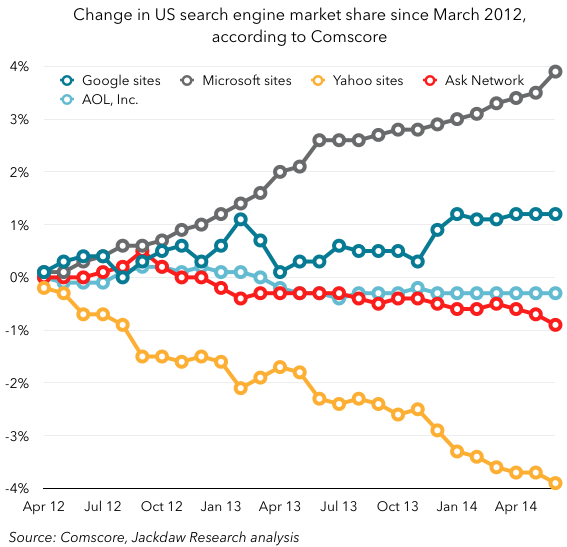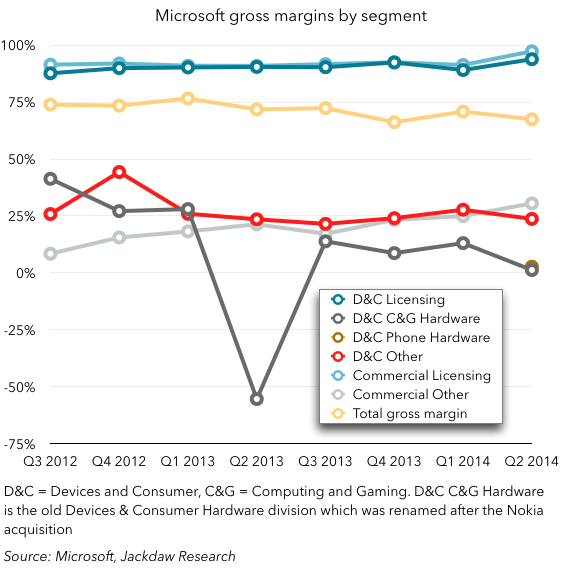In contrast to other quarters, in the fourth quarter Microsoft doesn’t release its in-depth SEC filing immediately. Since that’s where many of the juiciest bits of data land, we have limited information to go on so far. But I wanted to do a quick first-take on Microsoft’s earnings based on what we do know. Once the 10-K is out I will likely do a follow-up post on the additional detail. This is part of a series on Q2 2014 earnings – you can see the full set here.
Margins – Microsoft’s past versus its present
I wanted to start out with a quick look at Microsoft’s margins. These days it only gives us gross margins at the detailed segment level, so we’ll have to be satisfied with those. The chart below shows gross margins for the new set of segments, including the former Nokia devices business:
The data point for the former Nokia business is the brown circle hiding behind the last dark gray D&C C&G hardware circle, and it’s fitting in some ways that the margins for the two consumer hardware businesses should be so close to each other, at under 5%. By contrast, the two licensing businesses also have very similar gross margins, at over 90%. In the middle we have the nascent businesses: D&C Other and Commercial Other, which include all manner of products from enterprise cloud services to Bing. The contrast between hardware and licensing couldn’t be more stark: one makes enormous gross margins, and the other barely scrapes a profit. And yet that traditional licensing business is the past for Microsoft, while its other segments represent the future. It’s no wonder Nadella isn’t keen on first-party hardware for its own sake: it barely makes any money. But by the standards of the legacy Windows and Office businesses which make up the bulk of the licensing segments, Microsoft’s fastest-growing businesses are much less profitable too. They are becoming more profitable over time, with the help of scale, but they will never generate the same kind of margins as licensed software, which has almost zero incremental cost.
Together, these margin numbers help to explain why Nadella and Microsoft are taking the steps they are: hardware isn’t a very profitable business, and the emerging businesses, though they’re driving rapid growth, will never be as profitable as Microsoft’s past mainstays. As such, it needs to cut significantly to be able to achieve similar margins going forward, not least on the hardware side.
Bing and online advertising
One area where we do have enough detail to derive some numbers is online advertising, and it was an area that received some attention on the earnings call too. I’ve already covered Google and Yahoo’s online advertising businesses this quarter, so it’s worth looking at the similarities and differences between the three major US search advertising players. if anything, Microsoft is suffering more than the others in Display, but it’s actually doing fairly well in Search, though largely at the expense of its partner Yahoo. First, my estimate of Microsoft’s two online advertising businesses and their divergent fortunes:
 Search is growing strongly, at 40% year on year, but Display is declining rapidly, with a 15% year on year decline. Since Search is where most of the money is, that’s not a bad thing, and it’s apparently been enough to give Microsoft confidence that it can achieve profitability for Bing in the coming fiscal year. My estimate is that the online advertising business has had gross margins in the 30s for some time now, but it’s anyone’s guess what the contribution margin is below that. Microsoft quotes Comscore’s estimate of its US search share, so it’s worth looking at that data too, straight from Comscore:
Search is growing strongly, at 40% year on year, but Display is declining rapidly, with a 15% year on year decline. Since Search is where most of the money is, that’s not a bad thing, and it’s apparently been enough to give Microsoft confidence that it can achieve profitability for Bing in the coming fiscal year. My estimate is that the online advertising business has had gross margins in the 30s for some time now, but it’s anyone’s guess what the contribution margin is below that. Microsoft quotes Comscore’s estimate of its US search share, so it’s worth looking at that data too, straight from Comscore: I’ve chosen to show the change in share since March 2012, rather than absolute share, because it makes it easier to see who is taking share and from whom. And what’s very clear is that Google’s share has actually gone up during that time, though only slightly, while Microsoft’s gains have come almost entirely at the expense of Yahoo. Comscore also reports a “powered” by number for Google and Microsoft, and Microsoft’s share has only risen from 26% in March 2012 to 27.2% in June 2014. It’s largely the overall scale of the market, and the fact that Microsoft is bringing more of its share in-house, that’s driving improved margins and growth, rather than real increases in share over its major rival.
I’ve chosen to show the change in share since March 2012, rather than absolute share, because it makes it easier to see who is taking share and from whom. And what’s very clear is that Google’s share has actually gone up during that time, though only slightly, while Microsoft’s gains have come almost entirely at the expense of Yahoo. Comscore also reports a “powered” by number for Google and Microsoft, and Microsoft’s share has only risen from 26% in March 2012 to 27.2% in June 2014. It’s largely the overall scale of the market, and the fact that Microsoft is bringing more of its share in-house, that’s driving improved margins and growth, rather than real increases in share over its major rival.
An interesting wrinkle in all of this is Microsoft’s increasing involvement with Apple around search, which started with Bing’s role in Siri but has now expanded to power Spotlight search across iOS and OS X. I’m guessing Microsoft is paying some sort of traffic acquisition cost to be in this prime position and displace Google, but I’m curious as to how much, and what the payoff might be. Since Apple’s intention with these products is in some ways to answer the question for the user before he or she even hits a search engine, the revenue opportunity for Microsoft might be relatively small. It gets access to data, to be sure, but it’s not clear whether it will be a big money-spinner for Microsoft. It’ll definitely be worth watching on future earnings calls.
That’s it for now – I’ll have more to say when the 10-K lands (and when I get a breather between other companies’ earnings over the coming days). I’ll do a deeper dive on Apple tomorrow, and likely also cover Facebook tomorrow or the day after.

Pingback: New Microsoft same as the old Microsoft - My Tech Report()